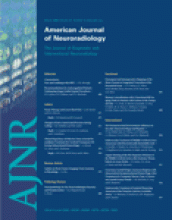Abstract
BACKGROUND AND PURPOSE: The purpose of this study is to determine whether interictal apparent diffusion coefficients (ADC) provide a robust means for detecting amygdalo-hippocampal abnormalities in adult patients with localization-related chronic temporal lobe epilepsy (TLE) undergoing presurgical evaluation.
METHODS: Fifty-five patients and 20 age-matched controls were studied with hippocampal and amygdala ADC maps (HADC and AMYADC), volumes (HCVOL, AMYVOL), T2 relaxometry (HCT2, AMYT2), and hippocampal N-acetylaspartate to choline and creatine/phosphocreatine ratios (HCSI). Mean values and 99% confidence ellipses were computed for the groups. Individual ADC mapping was compared with electroencephalography (EEG) data and further correlated with the quantitative MR measures and with the age at onset and duration of TLE. Moreover, we evaluated the association and the predictive value of HADC and AMYADC with respect to the surgical outcome in a subgroup of patients (n = 21) operated on the side of maximal EEG lateralization and with MR imaging criteria for hippocampal sclerosis, 71% of which became seizure-free.
RESULTS: In controls, there was no relation between ADC values and age, sex, or right-left asymmetries. In TLE groups with right (n = 29) or left epileptogenic foci (n = 26), group comparisons showed that ADC mapping detected changes ipsilateral to the focus in the hippocampus (P <.01) and the amygdala (P <.05), accordingly with the volumes, T2 maps, and HCSI. Significant Pearson correlations (2-tailed) were obtained between ADC maps and the volume of the hippocampus (r = −0.64) and of the amygdala (r = −0.55; both P <.01), T2 (r = 0.70, r = 0.29; both P <.01), but not with HCSI. Individual ADC analysis showed ipsilateral pathology in 82% of cases (hippocampus) and 35% (amygdala) and included a moderate association between ipsilateral HADC and AMYADC (r = 0.54; P <.01). Bilateral abnormalities were found in 7% (hippocampus) and 5% (amygdala) of cases. Except for HCSI and the amygdala data, there were significant correlations between the asymmetry indices and the duration of epilepsy (HADC: r = 0.42; HCT2: r = 0.50; HCVOL: r = 0.35; all P <.01). Age at onset was associated only with ipsilateral HADC (r = 0.35; P <.01) and HCVOL and HCT2 (both P <.05). The association with postsurgical successes was characteristic of HADC (Fisher exact test, 2-tailed: P =.031; Spearman correlation: rs = −0.75; P =.0002), but not AMYADC. The predictive value regarding a favorable outcome was 0.87 (odds ratio 26; 95% confidence interval 2.33–38.86). As determined by regression models, both larger ipsilateral HADCs and asymmetry indices predicted surgical success.
CONCLUSION: Interictal ADC mapping lateralizes efficiently the lesion side in accordance with the EEG data and might be used to study the differential regional aspects of mesio-temporal sclerosis. HADC—not AMYADC—maps discriminate favorably postoperative outcome and can be added to the multidisciplinary evaluation workout of pharmacoresistant TLE patients.
- Copyright © American Society of Neuroradiology












